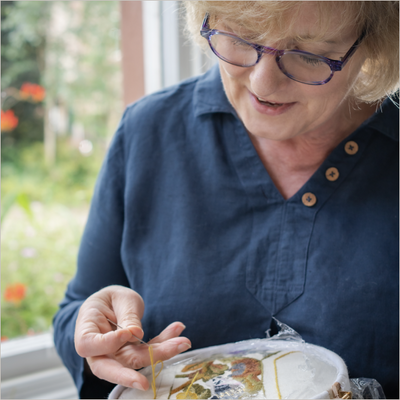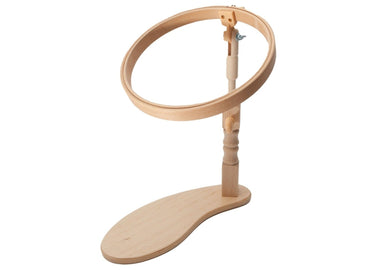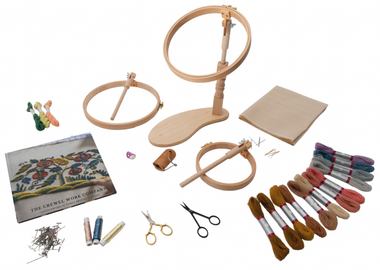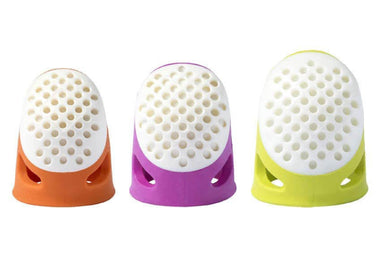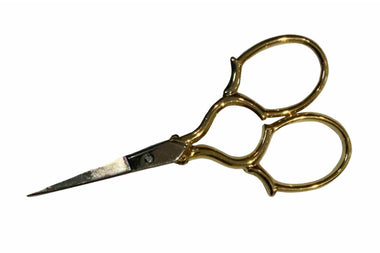Jenny Adin-Christie is a world-renowned professional hand-embroider and tutor whom we are privileged to include in our billing of top-class Lady Anne’s Needlework Retreat tutors.
Jenny's iconic designs employ an exquisite and intricate detail which she has become well-known for. If you are lucky enough to secure a spot in one of her sought-after classes, by the end you will be in possession of skills you only dreamt of acquiring and you will likely have created something which, in a 100 years, onlookers will gawp and gaze at, wondering how on earth it was made.
The Wordsworth Harp Needlecase, is one such design. This harp-shaped objet d'art is a celebration of our most treasured and essential tool, the needle. Not only does the harp serve as a convenient and delightful holder for a bespoke set of 26 tapered needles, but it's embellishment along its structure, which Jenny has evolved into a more intricate design than is featured on the original, elevates them to celestial heights. This design has never been replicated before and we are privileged to be able to provide permission for Jenny to do so, on behalf of the Wordsworth Trust Museum where the original harp is displayed.
Students at the Spring Residential 2018 at the Ryebeck Hotel in Windermere were treated to this design's very first outing. Jenny spent the large part of 2017 developing this design exclusively for Lady Anne's Needlework Retreats and we are delighted to present it this year as a headline project alongside Nicola Jarvis' Dove Cottage Sampler.
Read on to hear Jenny talk about the design in her own words.

The Story of the Needlecase:
Housed in the museum collection of the Wordsworth Trust at the Bard’s former home of Dove Cottage in the Lake District, is the most exquisite miniature harp, hand-made from silk covered card and decorated with a design of Irish shamrocks applied in tiny pieces of gold foil, housed in a tiny silk covered box. The harp includes a pillar, wrapped in silk and gold plate, surmounted by a silk covered finial, embellished with gold beads and needlelace. On closer inspection, one realises that the strings of the harp are formed from graded sizes of needles, and the piece is indeed a unique and intricately worked needlecase (see below).

 As well as being an exquisite object in its own right, the piece is of particular note for the Wordsworth Trust, since it was the topic for his poem ‘On Seeing a Needlecase in the Form of Harp’. Wordsworth talks about the harp being the work of the ‘Laureate’s Child’, referring to its original maker Edith May Southey (pictured right, together with Sara Coleridge), daughter of Robert Southey, Poet Laureate from 1813 to 1843, and friend of the Wordsworths. By kind permission of the Wordsworth Trust and Lady Anne’s Needlework Retreats, and of course with great thanks to Edith for her original idea!!... I have been given permission to recreate this beautiful little treasure! I have re-designed the harp in order to put my own stamp on the piece and to allow the decorative panels to be fully embroidered, rather than using adhesive applied foil shapes. The new design is based on lesser celandines. This tiny but beautiful wild flower, was known to be Wordsworth’s favourite.
As well as being an exquisite object in its own right, the piece is of particular note for the Wordsworth Trust, since it was the topic for his poem ‘On Seeing a Needlecase in the Form of Harp’. Wordsworth talks about the harp being the work of the ‘Laureate’s Child’, referring to its original maker Edith May Southey (pictured right, together with Sara Coleridge), daughter of Robert Southey, Poet Laureate from 1813 to 1843, and friend of the Wordsworths. By kind permission of the Wordsworth Trust and Lady Anne’s Needlework Retreats, and of course with great thanks to Edith for her original idea!!... I have been given permission to recreate this beautiful little treasure! I have re-designed the harp in order to put my own stamp on the piece and to allow the decorative panels to be fully embroidered, rather than using adhesive applied foil shapes. The new design is based on lesser celandines. This tiny but beautiful wild flower, was known to be Wordsworth’s favourite.
He wrote in ‘To the Small Celandine’:
Pansies, lilies, kingcups, daisies,
Let them live upon their praises;
Long as there’s a sun that sets,
Primroses will have their glory;
Long as there are violets,
They will have a place in story:
There’s a flower that shall be mine,
‘Tis the little celandine.

The design used a range of beautiful silk and metal threads, in a variety of surface embroidery techniques, all of which would have been used during the Victorian period.

The project has become a true marriage of old and new, inspired by the age-old hand skills and dedication to intricacy and beauty of the past, and yet linked today with very modern technology!
The 3 types of card for the construction have been created by James Cropper, master paper maker, appropriately of Kendal, Cumbria, who have been paper making since 1845. This has been cut by laser to give highly precise shapes.

The wooden finial and the wooden form which supports the soundbox of the harp, have been hand crafted by my Father, master gunsmith and fishing rod builder.
The 2% gold, specialist metal embroidery threads have been created using age old techniques by the master wyre drawers at Benton & Johnson in Warwickshire (founded in 1685).
The silk threads have been provided by Parisian company Au Ver a Soie, a family company who have been making silk threads since 1820.
The specially selected set of gradated needles have been created, with great attention to detail, by ‘Tulip’ who are based in Hiroshima in Japan, the home of Japanese needle making for over 300 years. The needles in the original harp were simply pushed into the fine silk fabric. I was keen to refine this a little and have replaced with a wool baize needle holder. Wool baize is a traditional fabric for storing needles in cases and helps to protect the needles.
The fabric is made by A W Hainsworth & Son of Pudsey, Yorkshire, who have been weaving wool since 1723!
Jenny will be teaching again for Lady Anne's Needlework Retreats next March at the Spring Residential 2019, the 4 Nations Tour in 2020 and Lady Anne's Needlework Festival in 2021 (more information to follow).
The Wordsworth Harp Needlecase was created especially for Lady Anne's Needlework Retreats and can be ordered here until April 30.


